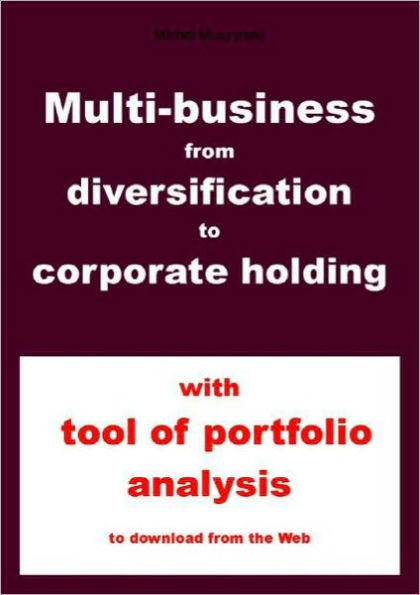A company is diversified when she runs two or more different businesses. The word “businesses” can refer either to lines of products or to company’s structure, however – since in the real world the corporate configuration always reflects company’s market situation - the most distinctive characteristics of diversified companies is certainly a large number of different products they sell.
Many actual enterprises are in such case. In USA General Electric with thousands of products, in Japan Yamaha with several different lines of goods marketed worldwide, in France famous Vivendi – it is easy to find many good examples. The question is how different are these diversified companies comparing to single business enterprises? Does a diversified company has to be managed differently than single product businesses? How to achieve the highest profitability of portfolio of products? Are all portfolio products independent or there can exist interactions between some of them? And are there any rules concerning financing of growing products by those which are in the advanced stages of the life cycle?
Finally, separating different businesses of a diversified company leads to building what is called “holding” organizational structure. Each of components of an holding corporation is an independent company, having a full autonomy, a proper statute, a separate management and very often also separate facilities. One thing is only common: the capital. How to manage this? Do holdings have any sort of advantage against simple diversified companies?
This book is for managers working on corporate strategy and for students of MBA programs. It gives the access to a tool of portfolio analysis downloadable from the Web.
1100817906
Many actual enterprises are in such case. In USA General Electric with thousands of products, in Japan Yamaha with several different lines of goods marketed worldwide, in France famous Vivendi – it is easy to find many good examples. The question is how different are these diversified companies comparing to single business enterprises? Does a diversified company has to be managed differently than single product businesses? How to achieve the highest profitability of portfolio of products? Are all portfolio products independent or there can exist interactions between some of them? And are there any rules concerning financing of growing products by those which are in the advanced stages of the life cycle?
Finally, separating different businesses of a diversified company leads to building what is called “holding” organizational structure. Each of components of an holding corporation is an independent company, having a full autonomy, a proper statute, a separate management and very often also separate facilities. One thing is only common: the capital. How to manage this? Do holdings have any sort of advantage against simple diversified companies?
This book is for managers working on corporate strategy and for students of MBA programs. It gives the access to a tool of portfolio analysis downloadable from the Web.
Multibusiness - from diversification to corporate holding
A company is diversified when she runs two or more different businesses. The word “businesses” can refer either to lines of products or to company’s structure, however – since in the real world the corporate configuration always reflects company’s market situation - the most distinctive characteristics of diversified companies is certainly a large number of different products they sell.
Many actual enterprises are in such case. In USA General Electric with thousands of products, in Japan Yamaha with several different lines of goods marketed worldwide, in France famous Vivendi – it is easy to find many good examples. The question is how different are these diversified companies comparing to single business enterprises? Does a diversified company has to be managed differently than single product businesses? How to achieve the highest profitability of portfolio of products? Are all portfolio products independent or there can exist interactions between some of them? And are there any rules concerning financing of growing products by those which are in the advanced stages of the life cycle?
Finally, separating different businesses of a diversified company leads to building what is called “holding” organizational structure. Each of components of an holding corporation is an independent company, having a full autonomy, a proper statute, a separate management and very often also separate facilities. One thing is only common: the capital. How to manage this? Do holdings have any sort of advantage against simple diversified companies?
This book is for managers working on corporate strategy and for students of MBA programs. It gives the access to a tool of portfolio analysis downloadable from the Web.
Many actual enterprises are in such case. In USA General Electric with thousands of products, in Japan Yamaha with several different lines of goods marketed worldwide, in France famous Vivendi – it is easy to find many good examples. The question is how different are these diversified companies comparing to single business enterprises? Does a diversified company has to be managed differently than single product businesses? How to achieve the highest profitability of portfolio of products? Are all portfolio products independent or there can exist interactions between some of them? And are there any rules concerning financing of growing products by those which are in the advanced stages of the life cycle?
Finally, separating different businesses of a diversified company leads to building what is called “holding” organizational structure. Each of components of an holding corporation is an independent company, having a full autonomy, a proper statute, a separate management and very often also separate facilities. One thing is only common: the capital. How to manage this? Do holdings have any sort of advantage against simple diversified companies?
This book is for managers working on corporate strategy and for students of MBA programs. It gives the access to a tool of portfolio analysis downloadable from the Web.
14.9
In Stock
5
1

Multibusiness - from diversification to corporate holding

Multibusiness - from diversification to corporate holding
Related collections and offers
14.9
In Stock

From the B&N Reads Blog
